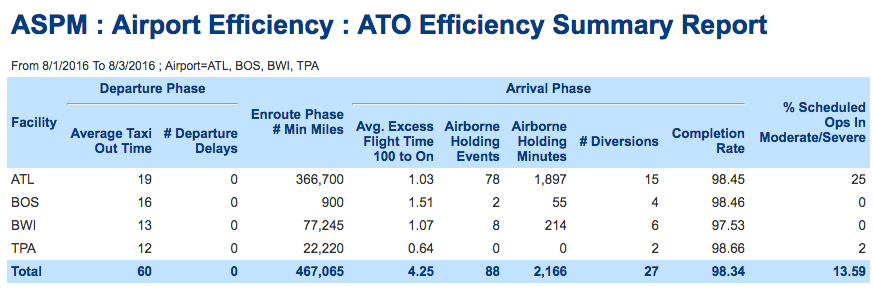ASPM Efficiency: ATO Efficiency Summary Report
From ASPMHelp
The ATO Efficiency Summary Report of ASPM Efficiency provides detail by facility and date for a series of metrics grouped by the Departure, En Route, and Arrival phases of flight. The Report can be generated only when the time frame is selected by day.
For information about how to create an ATO Efficiency Summary Report, see the ASPM Airport Efficiency Manual.
The fields in this report are defined below and are also available in ASPM Efficiency: Definitions of Variables.
The ATO Efficiency Summary Report contains the following variables:
- Departure Phase:
- Average Taxi Out Time. The average difference between Actual Gate Out time and Actual Wheels Off time, in minutes. Taxi out time is observed for flights for which OOOI data are available, otherwise it is estimated.
- Departure Delays. Number of OPSNET departure delays attributed to conditions at the departure airport. A component of OPSNET System Impact Delays and Occurred at Delays.
- Enroute Phase:
- Min Miles. A measure of the extent of En Route and Arrival Miles-In-Trail restrictions by arrival airport. Departure MITs are excluded. Minute-miles are calculated by multiplying the severity of the MIT restriction (in miles) by the duration of the MIT restriction (in minutes). For example, a 20 miles-in-trail restriction lasting 30 minutes = 600 minute/miles.
- Arrival Phase:
- Average Excess Flight Time 100 to ON. The average difference between the actual and unimpeded time from 100 miles from the arrival airport to wheels on. The unimpeded time is the average time in the previous 12-months, for the 20% of flights with the shortest travel distance from 100 to 40 miles from the airport, for a given 40 mile crossing point, equipment type, weight class, meteorological conditions, and runway configuration.
- Airborne Holding Events. The number of flights subjected to airborne holding. Airborne holding is a procedure where by enroute aircraft are issued a clearance for a predetermined maneuver which keeps aircraft within a specified airspace while awaiting further clearance from ATC. Airborne holding is caused by any number of factors: airport arrival demand exceeds airport arrival capacity, equipment outages, aircraft emergencies, enroute weather, airport gridlock, and sector saturation.
- Airborne Holding Minutes. The total number of minutes of holding for flights subjected to airborne holding.
- Diversions: Counts of flights that were diverted from their originally intended arrival airport as detected by an algorithm written by Mitre.
- Completion Rate. The percentage of scheduled and/or planned air carrier arrivals that were not cancelled. Calculated as Metric Arrivals/(Metric Arrivals + Cancelled Arrivals). Cancelled Arrivals are determined next day using air carrier flight plan cancellation messages and scheduled flights not flown. ASQP cancellation data are used when available.
- %Scheduled Ops in Moderate/Severe. The percent of scheduled arrivals and departures during periods in which the weather was classified as Moderate or Severe based on the ASPM weather factors methodology.
For information about other available reports in the Efficiency module, see the Display section.


